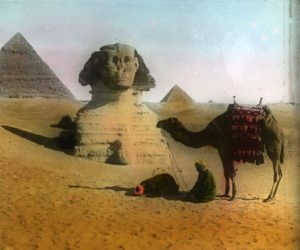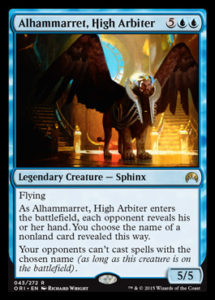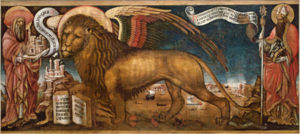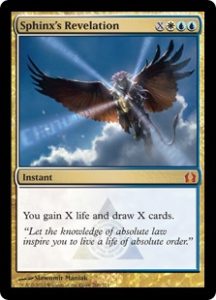This week’s Uncharted Realms took us to the plane of Vryn to meet a young Jace Beleren, a budding telepath and misunderstood youth living atop the mana rings that serve as a massive conduit for magical power on his plane. After an unhappy encounter with neighborhood bullies and a too-exemplary score on an exam, Jace is chosen as the pupil for an imposing mind mage: the sphinx Alhammarret. A being of immense power and intellect, Alhammarret owes his inspiration to millennia of human mythology and symbolism surrounding the enigmatic figure of the sphinx.
Mystery and Menace
In myth and legend on Earth, sphinxes have been associated with mystery, danger, and death since time immemorial throughout the cultures of the Mediterranean world. Ambiguous in omen and intent, sphinxes appear throughout art and architecture in Egyptian, Greek, and Mesopotamian/Assyrian civilization.1
One of the oldest and grandest depictions of these mythical beasts is the Great Sphinx at Giza, built more than four thousand years ago, possibly in honor of the Pharaoh Khafre (2,555 – 2532 BCE). Sculpted with the mantle of Egyptian royalty and the face of the Pharaoh, it is believed that the massive statue’s intent was to honor the sun gods and link Khafre’s line with solar divinity. Other theories abound, however, as the exact date, attribution, and intent of the Sphinx are still a source of debate. After the construction of the Great Sphinx, however, future Pharaohs continued to add Sphinx statuary to the monuments of Egyptian royal power and authority.
Influenced by contact with Egypt, the mythology and religious beliefs of Bronze Age Greece came to include sphinxes as well. Greek provides the modern name of the sphinx, possibly taken from its original Egyptian name or named for the act of strangulation – the means of killing prey used by lionesses which provided the sphinx’s leonine torso. Their enigmatic origin and name matched their reputation attributed by the Greeks. The singular Greek sphinx was a monster born of the legendary Chimera, a sibling of the Nemean Lion slain by Herakles and half-sister to Cerberus.
Monster and protector, divine and mortal, the sphinx was a figure of inscrutable intent and potential malice even within its own period.
Unlike the solar divinity with which it was associated in the Old Kingdom construction of Egypt, the sphinx of Hellenic mythology was a monster which menaced the city of Thebes, challenging citizens to answer its riddle correctly (“What walks on four legs in the morning, two in the afternoon, and three by nightfall?) or be devoured if incorrect. When the doomed hero Oedipus finally solves the riddle (“Man,” who crawls, then walks, then uses a cane in a long lifespan), the sphinx hurls herself to her death.2
Alhammaret himself appears to be an amalgam of the two mythical sources of the sphinx. Like the Egyptian depiction, he is masculine and regal rather than a monster. The Greek sphinx, however, added the wings we see on Alhammaret, as well as the aura of mystery that Jace’s mentor cultivates.
Elsewhere in the Mediterranean world, the Sphinx took on yet more meanings. Where it was a singular monster to the Greeks, it was seen across funerary structures in multiples for Phoenician and Assyrian construction. And while it had arguable connection with the sun’s holy power in Egyptian mythos, it was associated with death and depicted as fierce guardian of the tomb in Persian and Mesopotamian funerary architecture. Monster and protector, divine and mortal, the sphinx was a figure of inscrutable intent and potential malice even within its own period.
At The Doorway of Eternity
Long after these first depictions of the mythical sphinx, it saw further interpretations in medieval and Renaissance statuary and sculpture long after its connections to pagan divinity were supplanted. Animal symbolism, so vital to animist pagan practice before the common era, survived its translation into Christian lore in many ways, such as the demons and devils we explored in last week’s Planeswalker’s Guide. Although few mythical beasts made the direct transition to the comsos of medieval Christian belief, the sphinx could be at the root of artistic representation of the Apostle Mark.
According to the Biblical Book of Revelations, Mark was spiritually represented by a winged lion, crowned with a halo which signified his divine intent. The inspiration for this leonine saint, by happenstance or osmosis, echoes the Egyptian sphinx in its masculine identity (unlike the female sphinx of Thebes) and divine raiment, and draws upon the Greek sphinx in the Apostle’s revelatory role. Like the Greek monster and Alhammaret from this week’s Uncharted Realms, the Lion of Saint Mark was a keeper of secrets and hidden knowledge. Where he was depicted in his favored city Venice, he was portrayed with an open book, symbolizing the gift of divine guidance found in the Bible – except on the edifices of the naval Arsenal, where the book was closed to symbolically protect Venice’s maritime secrets and advantage. Medieval Venetians and Return to Ravnica era Standard players alike could agree upon the potentially devastating power of the Sphinx’s Revelation.
Sphinxes saw an artistic revival during the Renaissance, when European artists re-emphasized pre-Christian artistic forms and subject matters from the ancient world.3 In 16th century Italy, the Sphinx regained its female human face from Grecian legend as well as the role of enigmatic guardian taken from Mesopotamian and Egyptian funerary architecture. Long after its original depictions in Bronze Age sculpture, the Spinx endures as a symbol of mystery and menace, standing at the gateway of the unknown.
This is perhaps the greatest shared characteristic of Alhammaret and his counterparts in Earth’s history: their liminal place (at the boundary of two things) and enigmatic nature. To the Egyptian sculptors around 2500 BCE, the Sphinx represented both the Pharaoh and the divinity of the sun, both mortal and immortal, royal man and mythical beast. The ancient Greeks saw the sphinx of Thebes as a keeper of mystery, imbued with menace and promise alike for the heroic Oedipus who defeated her to achieve his heroic (and ultimately tragic) destiny. She also served in Greek myth as a transition between pre-Olympian religious practice and the religious order of the Olympian gods, just as did demons for early Christians and possibly the Lion of Saint Mark long after. And for the ancient Assyrians and Mesopotamians, the Sphinx stood as symbol and guardian of the greatest mystery of all, a watcher at the doorway of death.
Long after its original depictions in Bronze Age sculpture, the Spinx endures as a symbol of mystery and menace, standing at the gateway of the unknown.
Alhammaret is a keeper of secrets, hiding knowledge from both sides in Vryn’s conflict as well as the truth of Jace’s abilities and role from the budding planeswalker. But he is ultimately an gatekeeper as well, a guardian at the doorway to Jace’s own heroic destiny, and a watcher before the gates of other worlds. With his defeat, Jace solves a simple riddle – what it means to be a planeswalker – but (with the amnesiac trauma of telepathic battle combined with his first planeswalk) is thrust into an even greater mystery: what now does it mean to be himself?
Curtis Wiemann history history history old shoes.
1 Winged guardian beasts that basically fit the description above also appear in Southeast Asia, possibly independent of Mediterranean culture or possibly influenced by Macedonian conquest during the period of Alexander (c. 356-323 BCE).
2 There are other versions of the tale where she asks riddles whose meaning is lost a little in translation.
3 A note on this: the Renaissance didn’t rediscover ancient Greek and Roman art and architecture so much as shift the focus. Medieval Christian scholars, priests, and philosophers were (almost cripplingly) devoted to ancient Greek and Roman thought; they just focused mostly on themes and subjects that were possible to seperate from their pagan roots.





